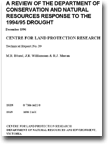Drought Management
Drought information for Victoria on the DPI website.
Information on Drought and Dry Seasonal Conditions on the DPI website (includes information on: Rural Finance Corporation, Water Cartage, Grants, DPI Dry Conditions Coordinators, Drought Management Information).
A full set of definitions of ‘drought’ can be found in Hounam, et. al., (1975). Standard definitions of drought refer to the occurrence of water within the hydrological cycle. They include;
- meteorological drought: a combination of climate features that lead to a deficiency of water in the climate phase of the hydrological cycle.
- agricultural drought: deficiencies of water at the crop water/ soil moisture level.
- hydrological drought: deficiencies in streamflow or groundwater resources.
In the past, drought planning in the region, and in Australia as a whole, has been reactive, resulting in inefficient allocation of water. Within the water sector, planning for short-term response to drought had previously involved water authorities placing ad hoc restrictions on water usage. Today, adequate planning necessitates detailing both short and long-term responses to meteorological, agricultural and hydrological drought. Such planning would be activated by drought indices (see Srikanthan and Stewart (1992) for particular indices).
Various storage and usage options exist to address the threat of drought in the Corangamite Catchment Management Region. They include:
- Surface water storage: on and off-stream storages.
- Groundwater (see Bartley, et. al., 1992).
- Reuse: treated sewage and grey water.
- Stormwater: for treatment and supply by water authorities.
- Networking systems: transfers of water within and between basins which were previously independent harvesting and supply systems.
- Rainwater tanks
- Dead storage pumping: water contained below conventional offtake levels.
- Water cartage: although this would be adopted only in emergency situations, which should not occur under adequate drought planning.
- Cloud seeding: a potential long-term measure, previously undertaken by the CSIRO to stimulate rainfall from suitable cloud formations.
Following the last major drought in the region (ie. during 1994/95), a drought monitoring farm survey was undertaken. This aimed to:
- Monitor rainfall, stock type and number, supplementary feeding, joining of stock, feed reserves, cropping and water details on selected farms throughout the region.
- Identify specific concerns and issues of landholders and initiate relevant extension activities.
- Supply information to Agriculture Victoria staff as well as State and Commonwealth Government organisations that were assessing drought conditions.
The nine drought management meetings held by Agriculture Victoria in late 1994 was found to assist producers to cope with the drought. This was achieved by providing a forum for technical information exchange and an opportunity for landholders to discuss the impending economic and social implications of the drought.
(Daunt and Gamble, 1996)
 | A Centre for Land Protection Research (CLPR) Review of the DCNR Response to the 1994/95 Drought is available for download. |
To view the information PDF requires the use of a PDF reader. This can be installed for free from the Adobe website (external link).
Information regarding preparing for drought, including developing an action plan is available for graziers within the Department of Primary Industries web site.
Relevant DPI Landcare and Agriculture Notes
| Drought reserve dams | "Drought proofing" is a set of strategies and works for enabling a property cope with extended dry periods. These include vegetation protection, stocking strategies, use of stock containment areas, fodder reserves and water reserves. |
| Paddock protection and stock management during dry times | The management of paddocks and stock during dry times requires considerable care to avoid degradation of soil and water, damage to plants or seeds and long term financial loses. We wish to avoid the degradation of 1982/83 though appropriate management. Paddocks should remain in such a condition that soil structure and fertility are protected and ready to respond to the return of wet weather. |
| How long will my dam water last? | This Landcare note is to help land managers calculate water demands being made by livestock on existing water storages, especially during drought periods. |
| Hints on feeding grain to cattle | There are three situations where grain might be fed to cattle - as a drought ration, as a supplement to grazing or in lotfeeding. In all cases care must be taken, especially in the introduction or conditioning of cattle to grain feeding. |
References
Bartley, J.G., Rhodes, B.G., and Moran, R.J (1992). Drought Management Plan for Victoria’s Water Resources: Status of Drought Relief Bores in Victoria. Department of Conservation and Natural Resources, Victoria.
Daunt, M., and Gamble, I (1996). 1994/95 Drought Monitor Farm Survey: Corangamite. (the former) NRE, Benalla.
Hounam, C.E., Burgosm, J.J., Kalik, M.S., Palmer, W.C., and Rodda, J.C (1975). Drought and Agriculture. Technical Note no. 138. WMO, Geneva, 127.
Klemes, V (1987). Drought prediction: A hydrological perspective. In Wilhite, D.A., and Easterling, W.E., (eds). Planning for Drought. Westview Press, Boulder, 81-94.
Semple, L.H (1993). Drought Management Plan for Victoria’s Water Resources: Supply Enhancement Options for Water Supply Systems. Department of Conservation and Natural Resources, Victoria.
Srikanthan, R., and Stewart, B.J (1992). Drought Assessment for Victoria: A Case Study. Bureau of Meteorology, Melbourne.


